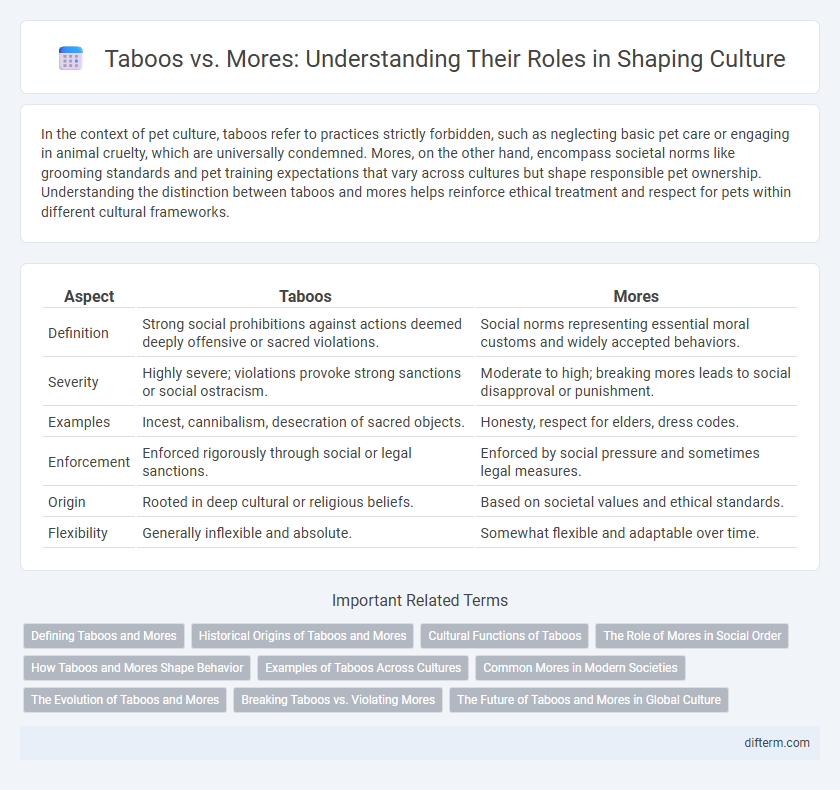In the context of pet culture, taboos refer to practices strictly forbidden, such as neglecting basic pet care or engaging in animal cruelty, which are universally condemned. Mores, on the other hand, encompass societal norms like grooming standards and pet training expectations that vary across cultures but shape responsible pet ownership. Understanding the distinction between taboos and mores helps reinforce ethical treatment and respect for pets within different cultural frameworks.
Table of Comparison
| Aspect | Taboos | Mores |
|---|---|---|
| Definition | Strong social prohibitions against actions deemed deeply offensive or sacred violations. | Social norms representing essential moral customs and widely accepted behaviors. |
| Severity | Highly severe; violations provoke strong sanctions or social ostracism. | Moderate to high; breaking mores leads to social disapproval or punishment. |
| Examples | Incest, cannibalism, desecration of sacred objects. | Honesty, respect for elders, dress codes. |
| Enforcement | Enforced rigorously through social or legal sanctions. | Enforced by social pressure and sometimes legal measures. |
| Origin | Rooted in deep cultural or religious beliefs. | Based on societal values and ethical standards. |
| Flexibility | Generally inflexible and absolute. | Somewhat flexible and adaptable over time. |
Defining Taboos and Mores
Taboos are powerful social prohibitions ingrained deeply within a culture, often surrounding topics considered sacred or forbidden, such as incest or cannibalism. Mores represent the essential customs and moral norms that guide acceptable behavior in a society, like honesty and respect for authority. Violating taboos typically evokes strong emotional reactions and sanctions, whereas breaching mores results in social disapproval but less severe consequences.
Historical Origins of Taboos and Mores
Taboos historically emerge from ancient religious beliefs and societal fears, often rooted in survival practices and sacred customs that prohibited behaviors threatening social order or spiritual well-being. Mores develop as moral norms reflecting a society's evolving ethical standards, primarily shaped by collective experiences and legal frameworks over time. Both taboos and mores play critical roles in maintaining cultural cohesion by delineating acceptable and unacceptable behaviors within a community.
Cultural Functions of Taboos
Taboos serve as powerful cultural mechanisms that regulate behavior by prohibiting actions deemed harmful or offensive within a society, effectively maintaining social order and cohesion. Unlike mores, which are enforced through social approval or disapproval, taboos are often accompanied by strong emotional reactions such as disgust or fear, reinforcing their role in safeguarding community values and collective identity. By delineating clear boundaries of acceptable conduct, taboos prevent social conflict and contribute to the preservation of cultural norms and traditions.
The Role of Mores in Social Order
Mores serve as fundamental norms that shape societal values and maintain social order by reinforcing ethical behavior within communities. They regulate behavior more strictly than taboos, often embodying the moral foundation necessary for social cohesion and stability. Violations of mores typically result in significant social sanctions, reflecting their critical role in preserving cultural integrity.
How Taboos and Mores Shape Behavior
Taboos and mores distinctly shape individual and collective behavior by establishing boundaries of acceptable conduct within a culture. Taboos, often forbidden actions deeply ingrained in societal norms, elicit strong emotional reactions when violated, guiding behavior through fear of social ostracism. Mores, embodying moral customs and ethics, regulate everyday interactions by promoting conformity to shared values and fostering social cohesion.
Examples of Taboos Across Cultures
Examples of taboos across cultures include the prohibition of eating beef in Hindu communities, the avoidance of pork in Islamic and Jewish traditions, and the strict norms against incestuous relationships worldwide. In Japan, discussing death openly is considered taboo, while in some Middle Eastern societies, public displays of affection are heavily restricted. These cultural taboos shape social behavior by enforcing unwritten rules that maintain group harmony and identity.
Common Mores in Modern Societies
Common mores in modern societies include prohibitions against theft, murder, and lying, reflecting fundamental values that maintain social order and trust. These mores often align with legal systems and are enforced through formal sanctions, distinguishing them from less critical folkways. Understanding these norms highlights the social consensus on acceptable behavior and the collective effort to uphold community well-being.
The Evolution of Taboos and Mores
Taboos and mores evolve as societies shift, reflecting changing cultural values and norms over time. While taboos are deeply ingrained prohibitions often tied to survival or sacred beliefs, mores represent societal ethics that adapt with collective experiences. This dynamic evolution showcases the interplay between tradition and progressive reform within cultural frameworks.
Breaking Taboos vs. Violating Mores
Breaking taboos involves actions that are considered deeply offensive and prohibited by cultural norms, often eliciting strong social sanctions or exclusion, such as incest or cannibalism. Violating mores, while still frowned upon and punishable, typically involves behaviors that disrupt societal order or morality, like lying or theft, but may result in formal penalties rather than extreme ostracism. Understanding the distinction helps clarify how societies enforce norms and maintain cultural cohesion through varied levels of social control.
The Future of Taboos and Mores in Global Culture
Taboos and mores shape cultural identity by enforcing social norms and moral boundaries across societies worldwide. As globalization accelerates, the future of taboos and mores involves dynamic shifts influenced by digital communication, cross-cultural interactions, and evolving ethical standards. Emerging cultural landscapes reflect increasing tolerance and reinterpretation of previously rigid taboos, signaling a complex balance between tradition and progressive values.
taboos vs mores Infographic

 difterm.com
difterm.com